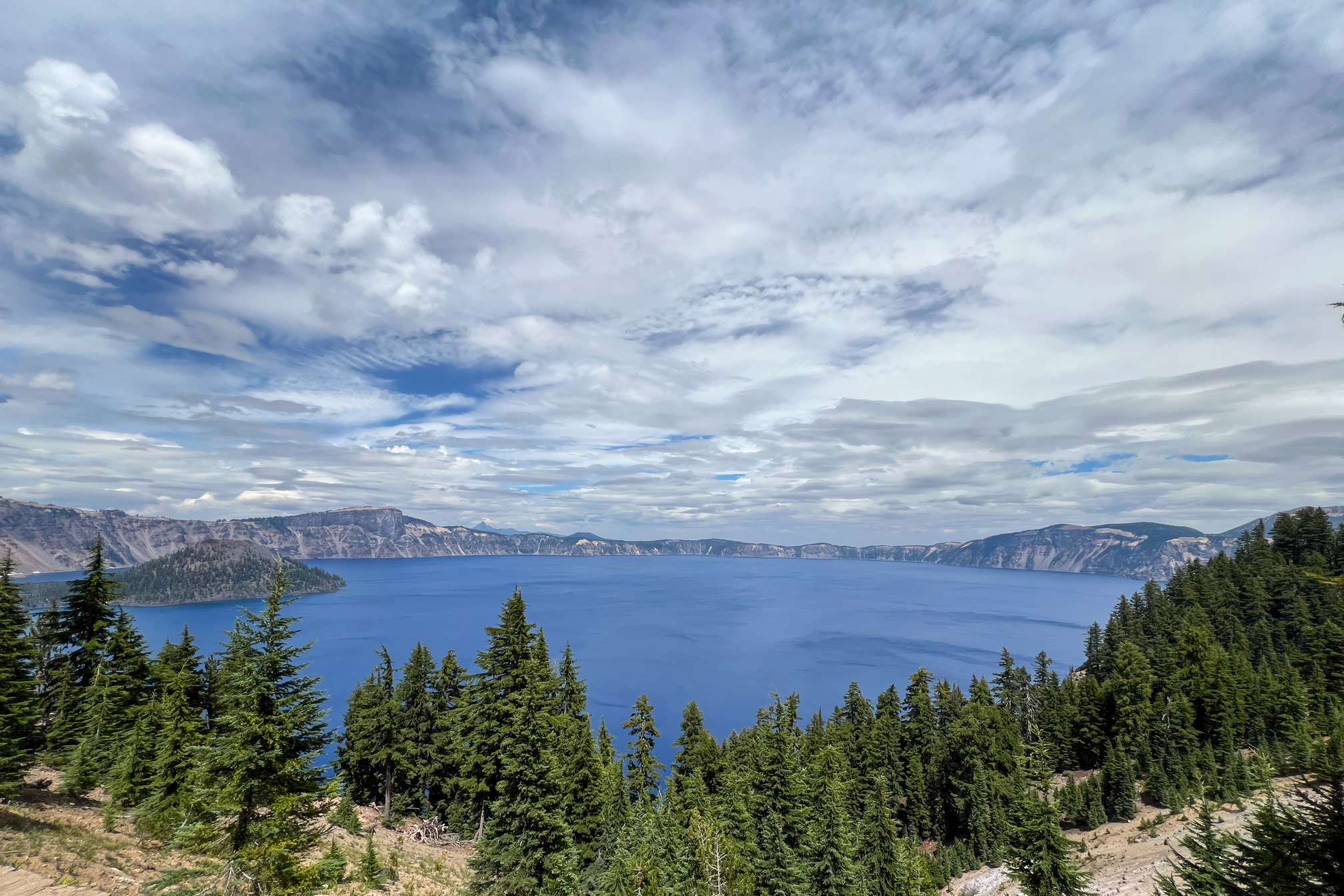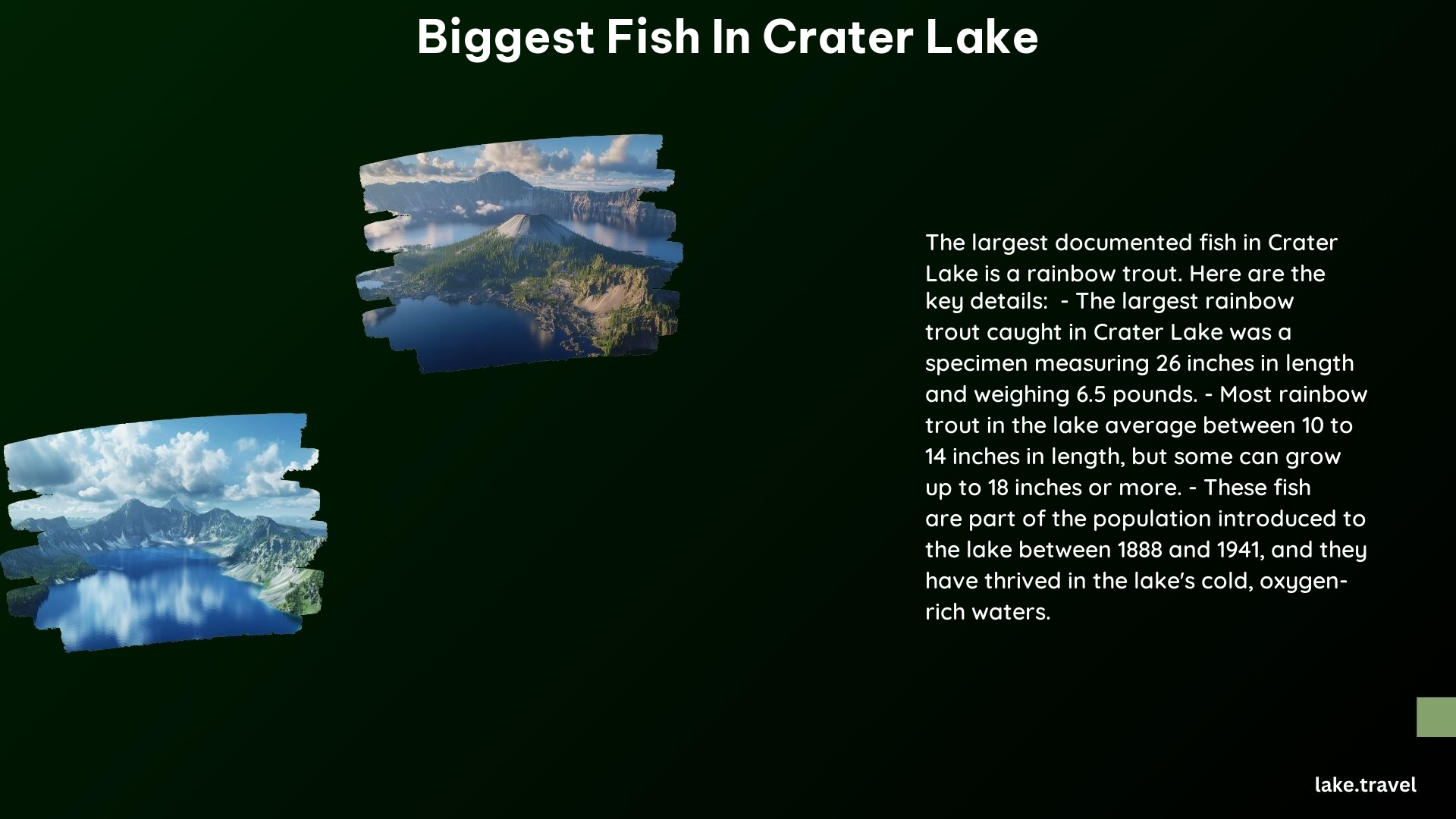Crater Lake, renowned for its pristine waters and unique ecosystem, harbors a fascinating aquatic world. The biggest fish in Crater Lake are rainbow trout and kokanee salmon, both non-native species introduced to the lake. The largest documented rainbow trout caught in Crater Lake measured an impressive 26 inches and weighed 6.5 pounds. While these fish thrive in the lake’s deep, cold waters, their presence and size offer intriguing insights into the lake’s ecology and the challenges of maintaining its natural balance.
What Makes Crater Lake Unique for Fish?

Crater Lake’s exceptional characteristics create a distinctive environment for its aquatic inhabitants:
- Depth: At nearly 2,000 feet deep, it’s the 8th deepest lake in the world.
- Water clarity: The lake’s famously clear waters allow for excellent visibility.
- Temperature: Cold year-round, perfect for trout and salmon.
- Oxygen levels: High oxygen content supports robust fish populations.
- Isolation: No natural inflows or outflows, creating a closed ecosystem.
These factors combine to create a challenging yet nurturing habitat for the lake’s fish populations, particularly the largest species.
What Are the Dominant Fish Species in Crater Lake?

The two primary fish species in Crater Lake are:
- Rainbow Trout (Oncorhynchus mykiss)
- Kokanee Salmon (Oncorhynchus nerka)
Both species were introduced to the lake in the early 20th century and have since established thriving populations. While these are the largest fish in the lake, it’s important to note that they are not native to this ecosystem.
How Big Do the Fish in Crater Lake Grow?
The size of fish in Crater Lake varies, but some impressive specimens have been recorded:
| Species | Average Size | Largest Recorded |
|---|---|---|
| Rainbow Trout | 10-14 inches | 26 inches, 6.5 pounds |
| Kokanee Salmon | 8 inches | Up to 18 inches |
The largest documented rainbow trout, measuring 26 inches and weighing 6.5 pounds, was recorded by the park research team. This exceptional size demonstrates the potential for growth in Crater Lake’s unique environment.
What Factors Contribute to Fish Size in Crater Lake?
Several factors influence the growth and size of fish in Crater Lake:
- Abundant food sources: Zooplankton for kokanee and aquatic insects for trout.
- Cold, oxygen-rich waters: Ideal conditions for these species.
- Lack of predators: Few natural predators in the lake.
- Vast habitat: The lake’s depth provides ample space for fish to grow.
- Water quality: Pristine conditions support healthy fish populations.
These elements combine to create an environment where fish can potentially grow to impressive sizes, as evidenced by the record-breaking trout.
How Does the Lake’s Ecosystem Support Large Fish?
Crater Lake’s ecosystem plays a crucial role in supporting its fish populations:
- Nutrient cycling: The lake’s depth and isolation create unique nutrient patterns.
- Plankton blooms: Seasonal blooms provide food for kokanee salmon.
- Insect populations: Aquatic insects serve as a food source for rainbow trout.
- Temperature stratification: Varying temperatures at different depths create diverse habitats.
- Clean water: The lake’s purity supports healthy fish growth.
This delicate balance allows for the existence of larger fish, though it also presents challenges in maintaining the ecosystem’s natural state.
What Are the Fishing Regulations for Crater Lake?
Fishing in Crater Lake comes with specific regulations designed to protect the lake’s ecosystem:
- No fishing license required
- No limit on catch
- Artificial bait only (to maintain water purity)
- Fishing prohibited within 200 feet of boat docks or swimming areas
- Access limited to Cleetwood Cove Trail (1.1 miles, 700-foot elevation change)
- Seasonal access: typically late June through October, weather permitting
These regulations aim to balance recreational fishing with conservation efforts, ensuring the continued presence of large fish in the lake.
When Is the Best Time to Fish for Big Fish in Crater Lake?
The optimal time for fishing in Crater Lake aligns with the park’s operational season:
- Late June to early October: When Cleetwood Cove Trail is open
- Summer months: Peak fishing season with warmer temperatures
- Early morning or late evening: Often most productive for fishing
- Boat tour season: Provides access to different areas of the lake
Anglers should note that weather conditions can change rapidly, affecting both access and fishing conditions.
How Has the Fish Population in Crater Lake Changed Over Time?
The fish population in Crater Lake has undergone significant changes since the introduction of non-native species:
- Early 1900s: Introduction of rainbow trout and kokanee salmon
- Mid-20th century: Population boom of introduced species
- Late 20th century: Efforts to remove non-native fish to restore natural ecosystem
- Present day: Managed populations of approximately 60,000 kokanee salmon and a smaller number of rainbow trout
These changes reflect the ongoing challenge of balancing recreational fishing with ecological preservation.
What Challenges Do Large Fish Face in Crater Lake?
Despite the favorable conditions, large fish in Crater Lake face several challenges:
- Limited food resources: Competition for available food sources
- Fluctuating water temperatures: Can affect fish distribution and growth
- Human impact: Fishing pressure and potential introduction of contaminants
- Genetic isolation: Limited gene pool due to the lake’s isolation
- Climate change: Potential long-term effects on lake ecology
Understanding these challenges is crucial for maintaining healthy populations of large fish in the lake.
How Do Researchers Study the Biggest Fish in Crater Lake?
Researchers employ various methods to study the fish populations in Crater Lake:
- Sonar surveys: To estimate population sizes and distribution
- Catch and release studies: For measuring and tagging individual fish
- Water quality monitoring: To assess habitat conditions
- Stomach content analysis: To understand feeding patterns
- Genetic studies: To monitor population health and diversity
These research efforts provide valuable insights into the lake’s largest fish and help inform conservation strategies.
In conclusion, the biggest fish in Crater Lake represent a fascinating aspect of this unique ecosystem. While the introduction of non-native species has altered the lake’s natural balance, it has also created opportunities for anglers and researchers alike. As we continue to study and appreciate these impressive fish, it’s crucial to balance recreational enjoyment with conservation efforts to preserve Crater Lake’s extraordinary aquatic environment for future generations.
References:
– https://www.craterlakeinstitute.com/general-natural-history-articles/animals/fish/fish-of-crater-lake/
– https://npshistory.com/nature_notes/crla/vol32-33c.htm
– https://www.nps.gov/crla/planyourvisit/fishing.htm
